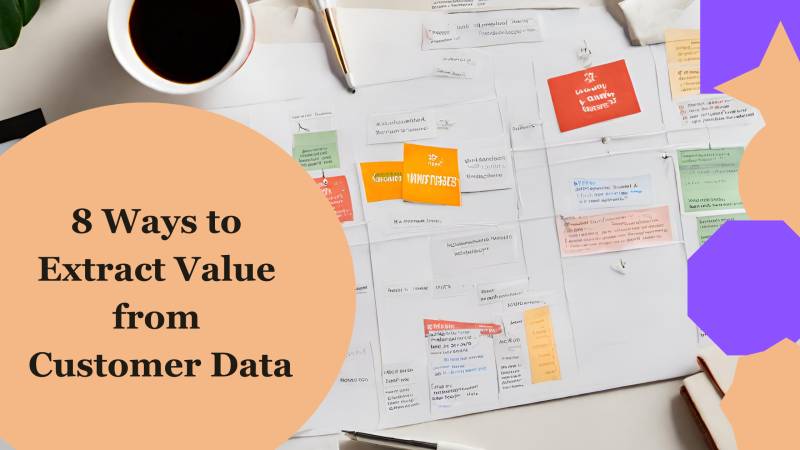
8 Ways to Extract Value from Customer Data¶
In today's digital age, businesses are swimming in a sea of customer data. From purchasing habits to browsing history, every interaction leaves behind a trail of valuable information waiting to be mined. However, the true challenge lies in extracting meaningful insights and leveraging them to enhance customer experiences and drive business growth.
Unlocking the full potential of customer data requires a strategic approach and the right tools. Here are eight proven strategies to help businesses extract maximum value from their customer data:
Table of Content¶
- Implement Robust Data Collection Mechanisms
- Utilize Advanced Analytics Techniques
- Personalize Customer Experiences
- Optimize Pricing and Promotions
- Improve Product Development
- Enhance Customer Service and Support
- Optimize Marketing and Advertising Campaigns
- Ensure Data Security and Compliance
Implement Robust Data Collection Mechanisms: ¶
Robust data collection mechanisms involve gathering information from various sources across the customer journey. This can include data collected from website analytics tools like Google Analytics, customer relationship management (CRM) systems, point-of-sale systems, social media platforms, surveys, and customer feedback mechanisms. Businesses should ensure that they collect data ethically and in compliance with relevant regulations like GDPR and CCPA.
Utilize Advanced Analytics Techniques: ¶
Advanced analytics techniques such as predictive modeling, machine learning, and segmentation analysis enable businesses to derive deeper insights from their data. Predictive modeling can forecast future trends and customer behaviors, while machine learning algorithms can uncover complex patterns within large datasets. Segmentation analysis helps businesses group customers into segments based on shared characteristics, allowing for more targeted marketing and personalized experiences.
Personalize Customer Experiences: ¶
Personalization is key to enhancing customer experiences and fostering stronger relationships. By leveraging customer data, businesses can tailor product recommendations, content, and messaging to individual preferences and behaviors. Personalization can occur across various channels, including websites, email marketing campaigns, mobile apps, and in-store interactions, creating a seamless and engaging experience for customers.
Optimize Pricing and Promotions: ¶
Customer data provides valuable insights into price sensitivities, purchasing patterns, and the effectiveness of promotional campaigns. By analyzing historical sales data and customer feedback, businesses can optimize pricing strategies and promotions to maximize revenue and customer satisfaction. Dynamic pricing algorithms can adjust prices in real-time based on factors like demand, competition, and customer behavior.
Improve Product Development: ¶
Customer data serves as a valuable source of feedback for product development and innovation. By analyzing product reviews, surveys, and customer support interactions, businesses can identify areas for improvement and new product opportunities. Additionally, analyzing purchasing patterns and market trends can help businesses stay ahead of evolving customer needs and preferences.
Enhance Customer Service and Support: ¶
Customer data plays a crucial role in enhancing customer service and support processes. By analyzing customer interactions, businesses can identify common pain points, trends in customer inquiries, and opportunities for service improvements. Implementing tools like chatbots and self-service portals can streamline support interactions and provide customers with faster, more efficient solutions.
Optimize Marketing and Advertising Campaigns: ¶
Segmentation and targeting are essential for optimizing marketing and advertising campaigns. By segmenting customers based on demographics, behaviors, and preferences, businesses can create highly targeted campaigns that resonate with specific audience segments. Analyzing campaign performance metrics allows businesses to refine their strategies and allocate resources more effectively across different marketing channels.
Ensure Data Security and Compliance: ¶
Data security and compliance are paramount when handling customer data. Businesses must implement robust security measures to protect sensitive customer information from unauthorized access, data breaches, and cyber threats. Additionally, compliance with regulations such as GDPR, CCPA, and PCI-DSS is critical to maintaining customer trust and avoiding costly penalties. Transparent data policies and proactive communication about data privacy practices help build trust with customers and demonstrate a commitment to protecting their personal information.
Conclusion¶
In conclusion, harnessing the power of customer data is essential for businesses striving to thrive in today's competitive landscape. Each of the eight strategies outlined - from robust data collection mechanisms to ensuring data security and compliance - serves as a foundational pillar in the journey towards extracting maximum value from customer insights.
By implementing these strategies effectively, businesses can:
- Gain deeper insights into customer behaviors, preferences, and trends.
- Personalize customer experiences, driving higher engagement and loyalty.
- Optimize pricing, promotions, and product development efforts based on data-driven analysis.
- Enhance customer service and support, improving satisfaction and retention rates.
- Refine marketing and advertising campaigns to maximize ROI and reach the right audience segments.
- Build trust with customers by prioritizing data security and compliance with regulations.
Moreover, the iterative nature of data analysis and utilization ensures that businesses can continuously refine their strategies and adapt to evolving customer needs and market dynamics.
In essence, the ability to extract value from customer data is not just a competitive advantage but a strategic imperative for businesses looking to stay ahead in today's data-driven economy. By leveraging customer insights effectively, businesses can unlock growth opportunities, drive innovation, and deliver exceptional experiences that resonate with their target audience.
 Dolly Solanki
Dolly Solanki
![]() Want to Share Your Views? Have Any Suggestions?
Want to Share Your Views? Have Any Suggestions?
If you want to
- provide some suggestions on topic
- share your views
- include some details in tutorial
- suggest some new topics on which we should create tutorials/blogs
Want to Get your Website on the First Page of Google SERP?
Reach out to CoderzColumn's digital marketer Dolly Solanki (dollyborade07@gmail.com). We can help you get a better ranking for your website.



 Want to Share Your Views? Have Any Suggestions?
Want to Share Your Views? Have Any Suggestions? digitalmarketing, customerdata, seo, robustdatacollection, marketingcampaign, advertisingcampaign, analyticstechnique, customerexperiences, prodcutdevelopment, CRM
digitalmarketing, customerdata, seo, robustdatacollection, marketingcampaign, advertisingcampaign, analyticstechnique, customerexperiences, prodcutdevelopment, CRM
